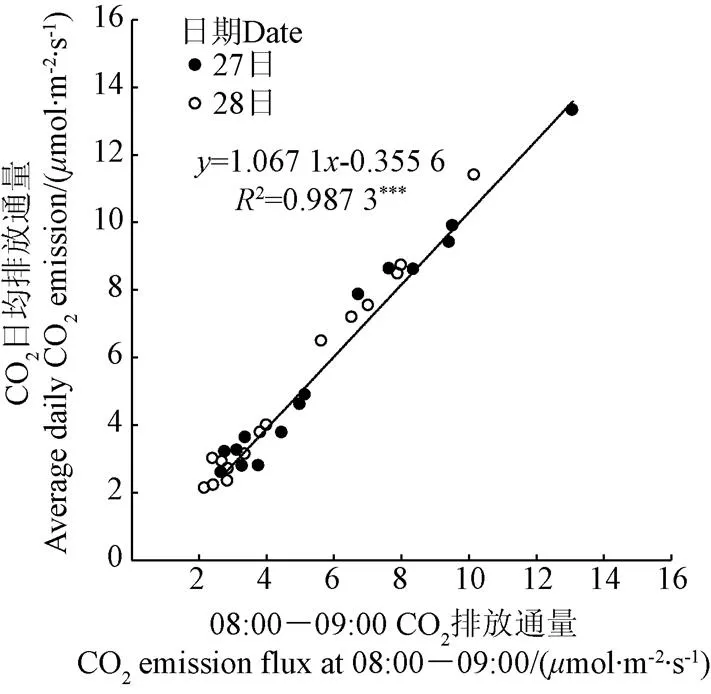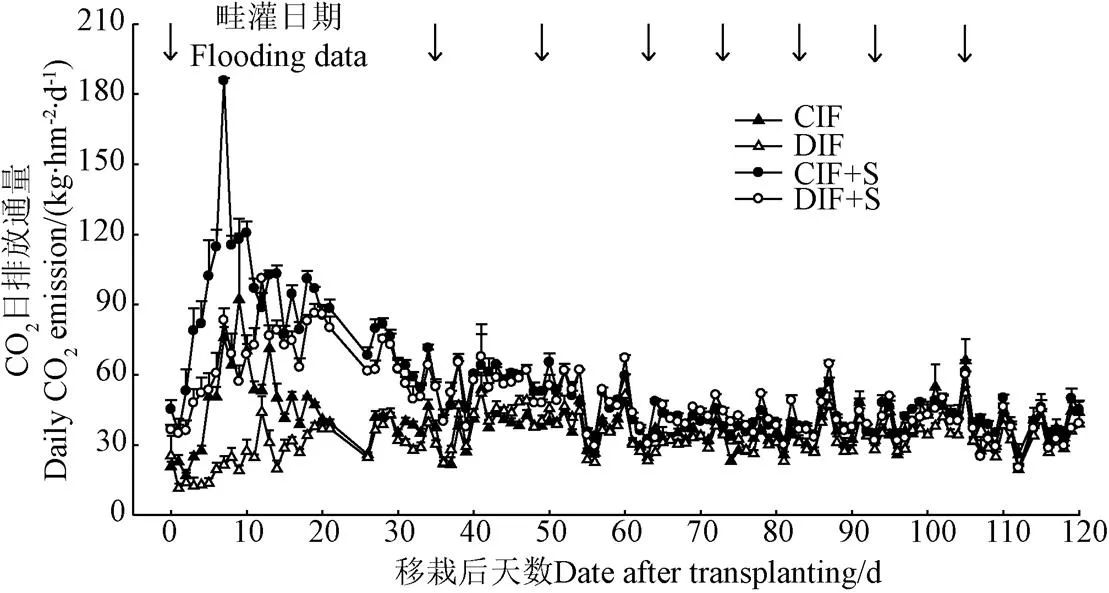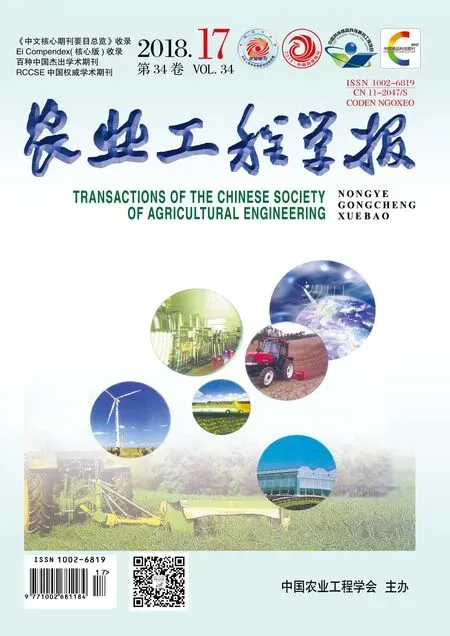灌溉方式和秸秆还田对设施番茄田CO2排放的影响
2018-09-03王亚芳吕昊峰杜九月李英杰廉晓娟王正祥王敬国
王亚芳,吕昊峰,杜九月,李英杰,廉晓娟,王正祥,王敬国,林 杉
灌溉方式和秸秆还田对设施番茄田CO2排放的影响
王亚芳1,吕昊峰1,杜九月1,李英杰1,廉晓娟2,王正祥2,王敬国1,林 杉1※
(1. 中国农业大学资源与环境学院,北京 100193;2. 天津农业科学科学院资源与环境研究所,天津 300100)
中国北方下沉式设施菜田表层土壤缺失,以及高温高湿的环境条件,导致耕层土壤有机质含量低、矿化快。如何减缓土壤有机质矿化,是该文所关注的焦点问题。该研究采用二因素试验设计,主因素为灌溉方式(传统畦灌施肥、滴灌施肥),副因素为秸秆(含C量为0、3 500 kg/hm2)。测定了48 h内每3 h的CO2排放通量,以及全生育期CO2日排放通量、土壤温度。结果表明:1)08:00−09:00测定的土壤CO2排放通量与CO2日均排放通量不存在显著差异,二者呈极显著线性正相关关系,其决定系数为0.987;而其他时段测定值与日均值均存在显著差异。2)与传统畦灌相比,无论是否添加秸秆,滴灌处理均显著降低了CO2累积排放量。3)CO2排放高峰出现在定植后8~15 d,随后逐渐降低并趋于平稳;定植后40 d内能检测到处理间CO2日排放通量的差异,此后处理间差异不显著。4)CO2累积排放通量和土壤积温呈显著正相关关系。综上所述,滴灌施肥栽培体系可显著降低土壤CO2排放量,有利于设施菜田土壤有机质的积累。
土壤;灌溉;排放控制;设施菜田;CO2排放通量;土壤呼吸;秸秆还田
0 引 言
中国设施蔬菜发展迅猛,1982年种植面积仅1万hm2,2013年达到370万hm2,占蔬菜种植面积的18%,总产量高达2.5亿t,占蔬菜总产量的34%[1]。设施蔬菜反季节栽培显著提高了产量和菜农的经济收入。然而,一方面,北方下沉式设施菜田表层土壤缺失,导致土壤有机质含量低和生产体系稳定性差[2];另一方面,菜农盲目追求产量和经济利益,采用大水大肥的栽培模式,以及高温高湿的环境条件,可能导致土壤有机质矿化快、积累慢。
土壤有机质是土壤肥力和作物产量的重要决定因子,可以改善土壤结构和保蓄性[3]。一般认为,当土壤有机质质量分数低于34 g/kg,土壤质量下降的潜在风险增加[4]。集约化耕作将加快有机质分解过程,导致有机质数量下降,引起有机质组分和质量退化[5]。因此,保持和提升土壤有机质含量,更新土壤有机质质量,提高活性有机质成分,成为当今国际土壤学最活跃的研究课题。Lal[6]指出,包括中国在内的发展中国家,增加土壤有机质是保障粮食安全的必然选择。虽然中国设施菜田的土壤有机质含量高于露地农田系统,但是仍然低于欧美国家设施蔬菜栽培土壤有机质含量的最低标准[7]。此外,为了降低冬季保温成本,中国菜农在设施蔬菜生产上常采用下沉式设施大棚,将表土移走建造保温墙,造成富含有机质的表层肥沃土壤缺失[2]。如何快速有效地提高设施菜田土壤有机质含量,进而提升土壤养分的保蓄和供应能力,以满足设施蔬菜快速生长对养分和水分的高需求,是中国设施蔬菜生产面临的技术瓶颈。
水分和氮肥是影响设施蔬菜栽培的重要因子,合理施肥灌溉将有利于设施蔬菜的生长。然而,过量水肥投入,一方面将造成土壤酸化和次生盐渍化、土壤结构破坏;另一方面,高温高湿的环境条件将加快土壤有机质分解[8-9],进而增加植物对外源水分和养分投入的依赖性。滴灌施肥一体化是解决上述矛盾的有效技术手段,除满足设施蔬菜对水肥的高需求外,还可大幅度减少对环境的负面影响。然而,滴灌施肥对土壤有机质和秸秆矿化的影响,则鲜见报道。
土壤有机碳的收支主要取决于有机物质的投入量和异养呼吸分解消耗量[10]。秸秆进入土壤,一部分被微生物异养呼吸分解释放到大气中,另一部分转化成土壤有机碳,土壤呼吸是土壤有机碳输出的主要途径,是陆地生态系统碳循环的重要组成部分[11],通常可将土壤呼吸划分为:微生物分解有机质的基础呼吸、根呼吸、根际微生物呼吸、激发效应引起的微生物分解植物残体及根系分泌物呼吸[12]。通过检测土壤呼吸CO2排放通量和累积排放量,有助于评价灌溉方式和添加秸秆对土壤有机质含量的间接影响。本文将在建立和完善土壤CO2日排放规律的基础上,评价2种灌溉施肥模式和秸秆还田对设施菜田土壤CO2累积排放量的影响。
1 材料与方法
1.1 试验设计与田间管理
试验于2016年3月至7月在天津农科院现代农业科技创新基地日光温室进行。该日光温室建于2011年,长70 m,宽7 m,北墙高3.5 m。表层0~30 cm土壤质地为粉砂质壤土,砂粒、粉粒和黏粒质量分数分别为30%、62%和8%,容重为1.34 g/cm3,pH值8.6,有机质质量分数34 g/kg。
试验采用二因素裂区设计,主因素为灌溉施肥方式(传统畦灌施肥、滴灌施肥一体化),副因素为秸秆还田(含C量为0、3 500 kg/hm2)。共设4个处理,分别为畦灌施肥(CIF)、畦灌施肥+秸秆(CIF+S)、滴灌施肥(DIF)、滴灌施肥+秸秆(DIF+S)。重复3次,共12个小区。小区间埋设防渗膜隔离至60 cm深,畦灌区和滴灌区防渗膜埋深90 cm。供试番茄品种为朝研圣迪,种苗为天津朝研种苗有限公司培育,留4穗果,每穗留果4~5个。采用当地典型的冬春茬和秋冬茬一年两熟种植制度,3~7月为冬春茬,3月11日定植,6月开始采收,7月9日收获完毕。小区面积6.7 m×3.6 m,每小区3畦,分别为土壤和植物样品采集区(6.7×1.2 m)、监测区(6.7×1.2 m)、测产区(6.7×1.2 m);畦宽1.2 m分宽窄行进行种植,宽行70 cm,窄行50 cm,4叶期番茄幼苗双行定植于窄行。畦灌区株距0.4 m,滴灌区株距0.35 m。所有处理基施商品鸡粪13 800 kg/hm2(相当于施N 200 kg/hm2),施玉米秸秆7 800 kg/hm2(相当于施C 3 500 kg/hm2)。在定植前,上述鸡粪和经粉碎的玉米秸秆均匀撒施地表后,立即旋耕。畦灌处理,按照当地农户传统习惯进行施肥灌溉。每季基施NPK复合肥2 060 kg/hm2(N:P2O5:K2O比例17-17-17,金正大复合肥料工程研究中心),定植后每15 d追施上述复合肥300 kg/hm2,全生育期共施用复合肥4 500 kg/hm2;浇定植水100 mm,每次施肥后浇水60 mm,总灌溉量600 mm。滴灌处理,依据目标产量法估算作物整个生育期内的需肥总量,然后根据作物不同生育期的需水肥规律,将其分配到每天进行滴灌施肥。在实际操作过程中,综合考虑土壤含水量、气象等因素进行滴灌施肥。通过在滴灌处理各小区内埋设张力计(张力计陶土头埋置地下20 cm处)来指示土壤水分变化,确定是否灌溉施肥;当张力计读数(09:00)达到控制灌溉水下限−20 kPa[13]时,即需要灌溉施肥;阴雨天,不进行滴灌施肥。浇定植水100 mm,定植15 d后进行滴灌施肥,除阴雨天外,每天灌溉量介于4~6 mm,全生育期灌溉量300 mm;平均每次施肥量14.7 kg/hm2,全生育期施肥量1 300 kg/hm2,滴灌肥N:P2O5:K2O比例19-8-27(圣诞树滴灌专用肥,北京富特森公司)。
1.2 测定与计算方法
每小区中间种植畦距离走道85 cm处,分别埋设长宽高分别为50 cm×50 cm×20 cm的不锈钢底座(厚度4 mm)。为了确保采样箱内外土壤水分和养分的交换,底座四周高10 cm处共开直径3 cm圆孔20个;为了确保底座与气体采样箱密闭,底座上部焊接宽1.5 cm、深1 cm水槽。定植前,底座埋入土壤,使其水槽上沿与地表持平。底座内和底座外40 cm范围内不种植植物,全生育期农事操作与常规操作保持一致。气体采样箱体积为0.5×0.5×0.5 m3,由厚度4 mm透明PVC板制成。气体箱两侧有通气口(玻璃胶密封),其顶部安装温度自动记录仪(EBI-20T,Ebro Instruments,Germany),记录测定时气体箱内的空气温度,并且顶部安装直径12 cm风扇,混匀气体箱内的气体。此外,每小区距土表10 cm处,埋设温度自动记录仪,精度0.1 ℃,记录每小时土壤温度。番茄果实转色时分次采收,将各小区测产区的果实全部称质量,计算单位面积番茄累积总产量。
应用CO2红外分析仪(GXH-3010E1,北京华云分析仪器研究所有限公司),测定土壤呼吸[14]。红外分析仪二氧化碳探头量程为0~1 000×10-6,最小测量精度为1×10−6。为了验证上午08:00-09:00测定的CO2排放通量,是否能够代表全天日均排放通量,于2016年3月27和28日检测了所有小区48 h内每3 h的CO2排放通量,进行了配对检验和相关性统计分析。
从定植开始,每天08:00-09:00采样测定箱体内CO2排放通量。将底座水槽内注入高约0.5 cm的水,将气体箱进气管以及出气管(直径4 mm)分别与红外分析仪的出气口和进气口相连,同时接通风扇电源,将气体箱平稳的扣在底座水槽内,开始测定。每次检测箱体内8个时间段CO2浓度,测定总时长240 s;采样时长20 s,采样间隔10 s。根据单位时间箱体内CO2浓度的变化,计算土壤CO2排放通量和累积排放量,计算公式如下。




式中3为CO2-C累积排放量,kg/hm2;为移栽后天数,d。
1.3 数据统计
数据处理和统计分析采用Excel 2013 和SAS V8.2软件,作二因素方差分析,包括灌溉施肥方式和有无添加秸秆,以及灌溉施肥方式和有无添加秸秆的交互作用。48 h的CO2排放通量,作配对检验和相关性统计分析。
2 结果与分析
从27、28日和二日平均值来看,上午08:00−09:00所测定的CO2排放通量与日均排放通量间,均不存在显著差异(表1);而其他时间段除28日11:00和23:00所测定排放通量与日均排放通量不存在显著差异外,均存在显著差异。此外,上午08:00−09:00所测定的CO2排放通量与日均排放通量间,存在极显著正相关关系,其决定系数为0.987(图1)。

表1 CO2日均排放通量与各时段排放通量平均值比较 Table 1 Average daily CO2 emission flux compared with average emission at different time periods
注:***,**,*分别代表0.001,0.01,0.05水平差异显著;ns,差异不显著。对于27或28日,=15。
Note: ***, **,* represent a significant difference at levels 0.001, 0.01, and 0.05, respectively; ns, not signification. For 27thor 28th,= 15.

图1 08:00-09:00土壤CO2排放通量与日均排放通量的相关关系图
移栽后30、60、90和120 d时,畦灌和滴灌处理间CO2累积排放量差异显著(图2)。与滴灌相比,畦灌显著增加了土壤CO2累积排放量;与不添加秸秆的处理相比,施用秸秆后各时间段CO2累积排放量均显著增加。定植后120 d时,畦灌和滴灌不施用秸秆时土壤呼吸CO2平均累积排放量分别为5 520和4 780 kg/hm2(图2)。与畦灌不添加秸秆处理相比(图3),添加秸秆后畦灌排放增加量为2 000 kg/hm2,而滴灌处理CO2排放增加量仅为1 200 kg/hm2,即畦灌和滴灌处理来自秸秆的CO2排放增量占秸秆碳投入量的比例分别为58%和36%(图3)。

注:CIF、DIF、S分别表示畦灌、滴灌和秸秆。不同大写字母表示灌溉施肥方式间差异显著,不同小写字母表示是否施用秸秆之间差异显著(P<0.05)。

注:不同大写字母表示灌溉方式间差异显著(P<0.05)。CO2排放增量=(秸秆还田处理CO2排放量–畦灌不加秸秆CO2排放量);CO2累积排放率(%)=秸秆还田处理CO2-C排放增量/秸秆C添加量×100%。
土壤CO2的排放高峰出现在移栽后10 d左右(图4),随后逐渐降低;移栽后40 d内可检测到处理间的显著差异,此后未检测到处理间的显著差异。土壤CO2累积排放动态曲线表明(图4),无论是否施用秸秆,畦灌处理CO2累积排放量均显著高于滴灌处理,并且与土壤积温呈极显著正相关关系(图5)。
不同处理下的番茄产量如表2所示。不添加秸秆时畦灌和滴灌番茄平均产量分别为(110±4.02)和(114±4.34) t/hm2,添加秸秆时则分别为(117±0.56)和(114±6.16) t/hm2,4个处理间均不存在显著性差异(不添加秸秆值=0.32,值= 0.602 7>0.05,添加秸秆值=0.18,值=0.689 7>0.05)。

注:图中箭头表示所有的畦灌灌溉日期。

图5 土壤CO2累积排放量与土壤积温的拟合

表2 不同处理下的番茄产量
3 讨 论
采用CO2红外分析仪-动态箱法,可方便快捷地检测设施菜田土壤CO2排放[15]。为了了解土壤CO2日变化特征,确定正确的采样测定时间,本试验48 h连续测定结果表明,每天上午08:00-09:00测定的土壤CO2排放通量与日排放通量的平均值,不存在显著差异(表1);并且二者之间存在极显著正相关关系(图1)。这为后续CO2排放通量的测定打下了良好的基础(表1,图1)。
下沉式设施菜田富含有机质的表层土壤缺失、土壤有机质矿化快和积累慢[8],不能满足设施蔬菜对水肥量大和强度高的需求,大水大肥成为中国设施菜田水肥管理的传统模式。定植后1-4个月,与传统畦灌相比,无论是否添加秸秆,滴灌处理均显著降低了CO2累积排放量(图2,3),这与曾睿等[16]和Lavigne[17]等的研究结果一致。传统畦灌施肥体系土壤含水量高,土壤呼吸速率则随着土壤含水量增加而提高[17]。滴灌施肥体系有效控制了水肥投入,显著降低了土壤CO2排放,有利于设施蔬菜土壤有机质的积累(图3)。传统畦灌施肥方式单次灌溉水量大,灌溉后短时间内可能抑制了土壤微生物和植物根系呼吸,随着水分蒸散,形成了有利于微生物活性的水热和通气环境[18],这从灌溉后第3天传统畦灌施肥CO2排放通量急剧增加,可以得到很好的验证(图4)。此外,传统畦灌后期水分的大量蒸散,表层土壤含水量低,造成干湿交替频繁发生,将激发土壤有机碳矿化[19]。
温度是影响土壤呼吸的主要因子[20],主要通过影响微生物、根生物量及根际活动,影响土壤呼吸,二者间具有明显的相关关系。CO2累积排放量与土壤积温呈显著正相关关系(图5),这与Adviento-Borbe等的研究结果一致[21]。不同处理CO2累积排放量与土壤积温拟合方程中斜率和截距的差异,则恰恰反映了相同温度条件下土壤水分和秸秆对土壤CO2排放的影响(图5)[22-24]。传统漫灌施肥条件下,添加秸秆为土壤微生物提供了大量碳源物质,进而显著增加了设施番茄土壤呼吸累积排放量[24-25];温度升高,将导致土壤微生物呼吸作用增强,CO2排放量增加[25]。
4 结 论
1)08:00-09:00测定的土壤CO2排放通量与CO2日均排放通量,不存在显著差异,且二者呈极显著线性正相关关系。CO2排放高峰出现在定植后8~15 d,随后逐渐降低并趋于平稳。
2)定植后40 d内能检测到传统畦灌与滴灌处理间CO2排放通量的差异,此后处理间差异不显著。
3)与传统畦灌相比,无论是否添加秸秆,滴灌处理均未减少番茄产量,不添加秸秆时畦灌和滴灌番茄平均产量分别为(110±4.02)和(114±4.34)t/hm2,添加秸秆时则分别为(117±0.56)和(114±6.16)t/hm2;但显著降低了土壤CO2排放强度和累积排放量,有利于设施菜田土壤有机质的积累。
4)不同处理CO2累积排放通量与土壤积温的拟合方程中斜率和截距的差异,可以很好地反映水分和秸秆对土壤CO2排放的影响。
[1] 董静,赵志伟,梁斌,等. 我国设施蔬菜产业发展现状[J]. 中国园艺文摘,2017,33(1):75-77.
[2] Fan Z B, Lin S, Zhang X M, et al. Conventional flooding irrigation causes an overuse of nitrogen fertilizer and low nitrogen use efficiency in intensively used solar greenhouse vegetable production[J]. Agricultural Water Management, 2014, 144(2): 11-19.
[3] Fialho R C, Zinn Y L. Changes in soil organic carbon under eucalyptus plantations in Brazil: A comparative analysis[J]. Land Degradation & Development, 2015, 25(5): 428-437.
[4] Loveland P, Webb J. Is there a critical level of organic matter in the agricultural soils of temperate regions: A review[J]. Soil & Tillage Research, 2003, 70(1): 1-18.
[5] Reeve J R, Smith J L, Carpenter-Boggs L, et al. Soil-based cycling and differential uptake of amino acids by three species of strawberry (.) plants[J]. Soil Biology & Biochemistry, 2008, 40(10): 2547-2552.
[6] Lal R. Soil carbon sequestration impacts on global climate change and food security[J]. Science, 2004, 304(5677): 1623-1627.
[7] Chen Z, Tian T, Gao L, et al. Nutrients, heavy metals and phthalate acid esters in solar greenhouse soils in Round-Bohai Bay-Region, China: Impacts of cultivation year and biogeography[J]. Environmental Science & Pollution Research, 2016, 23(13): 13076.
[8] 王敬国. 设施菜田退化土壤修复与资源高效利用[M]. 北京:中国农业大学出版社,2011.
[9] 巨晓棠,李生秀. 土壤氮素矿化的温度水分效应[J]. 植物营养与肥料学报,1998,4(1):37-42.
Ju Xiaotang, Li Shengxiu. The effect of temperature and moisture on nitrogen mineralization in soils[J]. Plant Nutrition & Fertilizenence, 1998, 4(1): 37-42. (in Chinese with English abstract)
[10] Jenkinson D S. The turnover of organic carbon and nitrogen in soil[J]. Philosophical Transactions of the Royal Society B Biological Sciences, 1990, 329: 361-367.
[11] Chang C T, Sabaté S, Sperlich D, et al. Does soil moisture overrule temperature dependency of soil respiration in Mediterranean riparian forests?[J]. Biogeosciences Discussions, 2014, 11(21): 7991-8022.
[12] Kuzyakov Y. Sources of CO2efflux from soil and review of partitioning methods[J]. Soil Biology & Biochemistry, 2006, 38(3): 425-448.
[13] 康跃虎. 实用型滴灌灌溉计划制定方法[J]. 节水灌溉,2004(3):11-12.
Kang Yuehu. Applied method for drip irrigation scheduling[J]. Water Saving Irrigation, 2004(3): 11-12. (in Chinese with English abstract)
[14] Pumpanen J, Kolari P, Ilvesniemi H, et al. Comparison of different chamber techniques for measuring soil CO2efflux[J]. Agricultural & Forest Meteorology, 2004, 123(3/4): 159-176.
[15] 任涛,李俊良,张宏威,等. 设施菜田土壤呼吸速率日变化特征分析[J]. 中国生态农业学报,2013,21(10):1217-1224.
Ren Tao, Li Junliang, Zhang Hongwei, et al. Analysis of daily dynamics of soil respiration rate in greenhouse vegetable fields[J]. Chinese Journal of Eco-Agriculture, 2013, 21(10): 1217-1224. (in Chinese with English abstract)
[16] 曾睿,梁银丽,要晓玮,等. 不同水分条件下温室番茄土壤呼吸变异性分析[J]. 灌溉排水学报,2011,30(6):111-114.
Zeng Rui, Liang Yinli, Yao Xiaowei, et al. Variation of tomato soil respiration in greenhouse under different soil moisture[J]. Journal of Irrigation & Drainage, 2011, 30(6): 111-114. (in Chinese with English abstract)
[17] Lavigne M B, Foster R J, Goodine G. Seasonal and annual changes in soil respiration in relation to soil temperature, water potential and trenching[J]. Tree Physiology, 2004, 24(4): 415.
[18] 杨洋,张玉龙,祁金虎,等. 灌溉方法对日光温室土壤呼吸的影响[J]. 生态学杂志,2016,35(11):2890-2895.
Yang Yang, Zhang Yulong, Qi Jinhu, et al. Effects of irrigation methods on soil respiration rate in sunlight greenhouse[J]. Chinese Journal of Ecology, 2016, 35(11): 2890-2895. (in Chinese with English abstract)
[19] 王健波. 耕作方式对旱地冬小麦土壤有机碳转化及水分利用影响[D]. 北京:中国农业大学,2014.
Wang Jianbo. Effect of Different Tillage Practices on Soil Organic Carbon Transformation and Water use in Dryland Winter Wheat[D]. Beijing: China Agricultural University, 2014. (in Chinese with English abstract)
[20] Kechavarzi C, Dawson Q, Bartlett M, et al. The role of soil moisture, temperature and nutrient amendment on CO2efflux from agricultural peat soil microcosms[J]. Geoderma, 2010, 154(3/4): 203-210.
[21] Adviento-Borbe M A A, Haddix M L, Binder D L, et al. Soil greenhouse gas fluxes and global warming potential in four high-yielding maize systems[J]. Global Change Biology, 2007, 13(9): 1972-1988.
[22] 宋秋来,赵泽松,龚振平,等. 东北黑土区旱作农田土壤CO2排放规律[J]. 农业工程学报,2012,28(23):200-207.
Song Qiulai, Zhao Zesong, Gong Zhenping, et al. CO2emission law of dry farmland soil in black soil region of Northeast China[J]. Transactions of the Chinese Society of Agricultural Engineering(Transactions of the CSAE), 2012, 28(23): 200-207. (in Chinese with English abstract)
[23] 陈玉章. 不同覆盖和秸秆还田方式对旱作小麦土壤温度的影响[D]. 兰州:甘肃农业大学,2013.
Chen Yuzhang. Effects of Different Mulching and Straw Returning Methods of Wheat on Soil Temperatures in Dryland Area[D]. Lanzhou: GanSu Agricultural University, 2013. (in Chinese with English abstract)
[24] 张庆忠,吴文良,王明新,等. 秸秆还田和施氮对农田土壤呼吸的影响[J]. 生态学报,2005,25(11):2883-2887.
Zhang Qingzhong, Wu Wenliang, Wang Mingxin, et al. The effects of crop residue amendment and N rate on soil respiration[J]. Acta Ecologica Sinica, 2005, 25(11): 2883-2887. (in Chinese with English abstract)
[25] 刘军,黄金花,杨志兰,等. 长期连作及秸秆还田棉田土壤呼吸变化特征[J]. 生态环境学报,2015(5):791-796.
Liu Jun, Huang Jinhua, Yang Zhilan, et al. Soil respiration variation characteristics of continuous cropping and straw incorporation cotton field[J]. Ecology & Environmental Sciences, 2015(5): 791-796. (in Chinese with English abstract)
Effect of irrigation and straw returning on soil CO2emissions in greenhouse tomato
Wang Yafang1, Lü Haofeng1, Du Jiuyue1, Li Yingjie1, Lian Xiaojuan2, Wang Zhengxiang2, Wang Jingguo1, Lin Shan1※
(1.,,100193,; 2.,300100,)
The greenhouse vegetable production has become one of the most promising agricultural industry in China with a rapid increase of planting area during the last two decades. Over-fertilization combined with improper irrigation dramatically increases nutrient losses and environmental pollution. However, the absence of surface soil, high temperature and moisture usually lead to low content on soil organic carbon and rapid soil mineralization in the sunken greenhouse vegetable production, northern China. Accumulation of soil organic carbon is slow even when straw is applied for a long period with conventional flooding irrigation. Promoting the sustainability of intensive used solar greenhouse vegetable production by optimizing irrigation and straw application management may have a positive impact. Our study in this paper focused on 1) whether straw returning can decrease mineralization rate of soil organic carbon and increase its accumulation with drip irrigation; and 2) suitable sampling schedule to measure daily CO2emission flux. A two-factor field experiment with three replicates was carried out which included two irrigation methods, i.e. conventional flooding irrigation fertilization and drip irrigation. Fertilization was combined with straw application rate of 0 and 3 500 kg/hm2. The four treatments are: conventional flooding irrigation with over-fertilization according to farmer’s practice (CIF); CIF + maize straw (CIF+S), drip irrigation with optimizing fertilization (DIF); and DIF + maize straw (DIF+S). Each plot (6.7 m × 3.6 m) consisted of three raised beds (0.7 m in width) and the walk way was 0.5 m in width between the raised beds. One of the three raised beds was used for measuring the fruits yield, one for monitoring CO2emission and other one for collecting soil and plant samples. In order to minimize lateral seepage of water and nutrients, we separated the plots with impermeable film to the depth of 0.6 m. One-month-old tomato seedlings were transplanted on raised beds with a handheld transplanting tool. Four fruit clusters were retained at each growing season and each cluster reserved four fruits. Gas flux chambers were composed of a permanent frame (50 cm width × 50 cm length × 20 cm depth) that was pre-installed in each plot before transplanting, and the height of top sampling chambers was 50 cm. The CO2fluxes were on line determined daily by using of CO2infrared spectrometer over the growth period between 08:00 am and 09:00 am at 30-second intervals during the closure time of 4 min (i.e., at time 0 and after 30, 60, 90, 120, 150, 180, and 240 s). The CO2gas fluxes were calculated from the slope of linear regressions of gas concentrations against the chamber closure time. The results showed that no significant difference on soil CO2emission flux was found between the measurements from 08:00-09:00 am and the daily average, and they were significant positively correlated, the coefficient of determination between was 0.987, while CO2emission measured in other time intervals were significantly different from daily average. Moreover, compared with conventional irrigation fertilization, the accumulated CO2emissions was significantly decreased in drip irrigation fertilization without reduction of the tomato fruit yield, regardless of whether straw was applied or not. In addition, the peak of CO2emission occurred during 8-15 d after transplanting, then CO2emission decreased and then stabilized. The difference of daily CO2emission flux among treatments can only be detected within 40 days after transplanting, and afterward there was no significant difference among treatments. Finally, there was a significant positive correlation between cumulative CO2emission and soil temperature. Our results demonstrated that drip irrigation fertilization can significantly reduce soil CO2emission and potentially improve the soil organic matter accumulation in the sunken solar greenhouse vegetable production.
soils; irrigation; emission control; greenhouse vegetable production; CO2emission flux; soil respiration; straw returning
2018-04-23
2018-07-11
国家科技支撑计划项目(2015BAD23B01-4);国家自然科学基金项目(41761134087)
王亚芳,博士生,主要从事菜田土壤碳氮转化的研究。Email:15701574181@163.com
林 杉,教授,博士生导师,主要从事植物营养生理生态研究。Email:linshan@cau.edu.cn
10.11975/j.issn.1002-6819.2018.17.011
S152.6
A
1002-6819(2018)-17-0076-06
王亚芳,吕昊峰,杜九月,李英杰,廉晓娟,王正祥,王敬国,林 杉. 灌溉方式和秸秆还田对设施番茄田CO2排放的影响[J]. 农业工程学报,2018,34(17):76-81. doi:10.11975/j.issn.1002-6819.2018.17.011 http://www.tcsae.org
Wang Yafang, Lü Haofeng, Du Jiuyue, Li Yingjie, Lian Xiaojuan, Wang Zhengxiang, Wang Jingguo, Lin Shan. Effect of irrigation and straw returning on soil CO2emissions in greenhouse tomato[J]. Transactions of the Chinese Society of Agricultural Engineering (Transactions of the CSAE), 2018, 34(17): 76-81. (in Chinese with English abstract) doi:10.11975/j.issn.1002-6819.2018.17.011 http://www.tcsae.org
